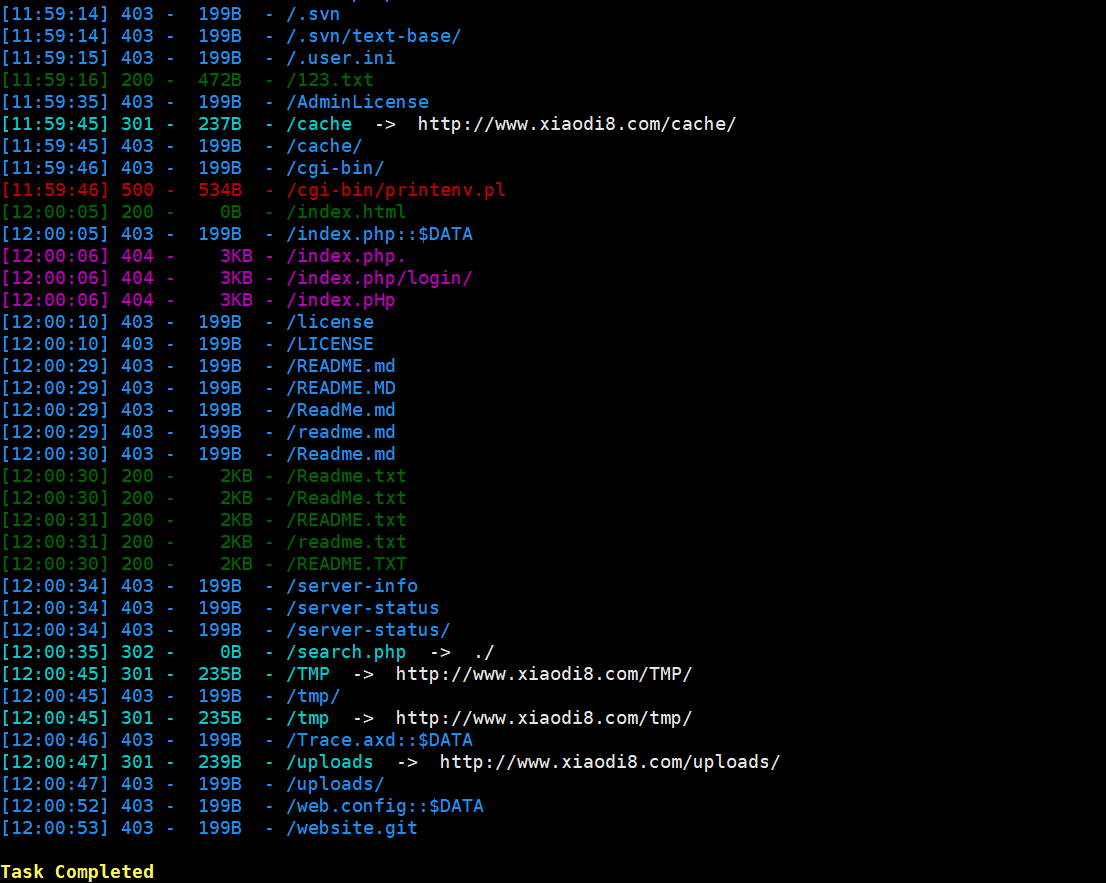目录
安装和使用
要求:python 3.9 或更高版本
选择以下安装选项之一:
- 使用git安装:(
git clone https://github.com/maurosoria/dirsearch.git --depth 1推荐) - 使用 ZIP 文件安装:点击此处下载
- 使用 Docker 安装:(更多信息可以在这里
docker build -t "dirsearch:v0.4.3" .找到) - 使用 PyPi 安装:
pip3 install dirsearch或者pip install dirsearch - 使用 Kali Linux 安装:(
sudo apt-get install dirsearch已弃用)
单词表(重要)
概括:
- Wordlist是一个文本文件,每行是一个路径。
- 关于扩展,与其他工具不同,dirsearch 仅用-e
%EXT%标志中的扩展名替换关键字。 - 对于没有的单词列表
%EXT%(例如SecLists),需要使用-f | –force-extensions开关将扩展名附加到单词列表中的每个单词以及/。 - 要将扩展名应用于已有扩展名的单词列表条目,请使用-O | –overwrite-extensions(注意:某些扩展名不会被覆盖,例如.log、.json、.xml …… 或媒体扩展名,如.jpg、.png)
- 要使用多个单词列表,您可以用逗号分隔单词列表。例如:
wordlist1.txt,wordlist2.txt。
例子:
- 正常扩展:
index.%EXT%
传递asp和aspx作为扩展名将生成以下字典:
index
index.asp
index.aspx
- 强制扩展:
admin
使用-f / –force-extensions标志将php和html作为扩展传递将生成以下字典:
admin
admin.php
admin.html
admin/
- 覆盖扩展:
login.html
使用-O / –overwrite-extensions标志将jsp和jspa作为扩展传递将生成以下字典:
login.html
login.jsp
login.jspa
选项
Usage: dirsearch.py [-u|--url] target [-e|--extensions] extensions [options]
Options:
--version show program's version number and exit
-h, --help show this help message and exit
Mandatory:
-u URL, --url=URL Target URL(s), can use multiple flags
-l PATH, --urls-file=PATH
URL list file
--stdin Read URL(s) from STDIN
--cidr=CIDR Target CIDR
--raw=PATH Load raw HTTP request from file (use '--scheme' flag
to set the scheme)
--nmap-report=PATH Load targets from nmap report (Ensure the inclusion of
the -sV flag during nmap scan for comprehensive
results)
-s SESSION_FILE, --session=SESSION_FILE
Session file
--config=PATH Path to configuration file (Default:
'DIRSEARCH_CONFIG' environment variable, otherwise
'config.ini')
Dictionary Settings:
-w WORDLISTS, --wordlists=WORDLISTS
Wordlist files or directories contain wordlists
(separated by commas)
-e EXTENSIONS, --extensions=EXTENSIONS
Extension list separated by commas (e.g. php,asp)
-f, --force-extensions
Add extensions to the end of every wordlist entry. By
default dirsearch only replaces the %EXT% keyword with
extensions
-O, --overwrite-extensions
Overwrite other extensions in the wordlist with your
extensions (selected via `-e`)
--exclude-extensions=EXTENSIONS
Exclude extension list separated by commas (e.g.
asp,jsp)
--remove-extensions
Remove extensions in all paths (e.g. admin.php ->
admin)
--prefixes=PREFIXES
Add custom prefixes to all wordlist entries (separated
by commas)
--suffixes=SUFFIXES
Add custom suffixes to all wordlist entries, ignore
directories (separated by commas)
-U, --uppercase Uppercase wordlist
-L, --lowercase Lowercase wordlist
-C, --capital Capital wordlist
General Settings:
-t THREADS, --threads=THREADS
Number of threads
--async Enable asynchronous mode
-r, --recursive Brute-force recursively
--deep-recursive Perform recursive scan on every directory depth (e.g.
api/users -> api/)
--force-recursive Do recursive brute-force for every found path, not
only directories
-R DEPTH, --max-recursion-depth=DEPTH
Maximum recursion depth
--recursion-status=CODES
Valid status codes to perform recursive scan, support
ranges (separated by commas)
--subdirs=SUBDIRS Scan sub-directories of the given URL[s] (separated by
commas)
--exclude-subdirs=SUBDIRS
Exclude the following subdirectories during recursive
scan (separated by commas)
-i CODES, --include-status=CODES
Include status codes, separated by commas, support
ranges (e.g. 200,300-399)
-x CODES, --exclude-status=CODES
Exclude status codes, separated by commas, support
ranges (e.g. 301,500-599)
--exclude-sizes=SIZES
Exclude responses by sizes, separated by commas (e.g.
0B,4KB)
--exclude-text=TEXTS
Exclude responses by text, can use multiple flags
--exclude-regex=REGEX
Exclude responses by regular expression
--exclude-redirect=STRING
Exclude responses if this regex (or text) matches
redirect URL (e.g. '/index.html')
--exclude-response=PATH
Exclude responses similar to response of this page,
path as input (e.g. 404.html)
--skip-on-status=CODES
Skip target whenever hit one of these status codes,
separated by commas, support ranges
--min-response-size=LENGTH
Minimum response length
--max-response-size=LENGTH
Maximum response length
--max-time=SECONDS Maximum runtime for the scan
--exit-on-error Exit whenever an error occurs
Request Settings:
-m METHOD, --http-method=METHOD
HTTP method (default: GET)
-d DATA, --data=DATA
HTTP request data
--data-file=PATH File contains HTTP request data
-H HEADERS, --header=HEADERS
HTTP request header, can use multiple flags
--headers-file=PATH
File contains HTTP request headers
-F, --follow-redirects
Follow HTTP redirects
--random-agent Choose a random User-Agent for each request
--auth=CREDENTIAL Authentication credential (e.g. user:password or
bearer token)
--auth-type=TYPE Authentication type (basic, digest, bearer, ntlm, jwt)
--cert-file=PATH File contains client-side certificate
--key-file=PATH File contains client-side certificate private key
(unencrypted)
--user-agent=USER_AGENT
--cookie=COOKIE
Connection Settings:
--timeout=TIMEOUT Connection timeout
--delay=DELAY Delay between requests
-p PROXY, --proxy=PROXY
Proxy URL (HTTP/SOCKS), can use multiple flags
--proxies-file=PATH
File contains proxy servers
--proxy-auth=CREDENTIAL
Proxy authentication credential
--replay-proxy=PROXY
Proxy to replay with found paths
--tor Use Tor network as proxy
--scheme=SCHEME Scheme for raw request or if there is no scheme in the
URL (Default: auto-detect)
--max-rate=RATE Max requests per second
--retries=RETRIES Number of retries for failed requests
--ip=IP Server IP address
--interface=NETWORK_INTERFACE
Network interface to use
Advanced Settings:
--crawl Crawl for new paths in responses
View Settings:
--full-url Full URLs in the output (enabled automatically in
quiet mode)
--redirects-history
Show redirects history
--no-color No colored output
-q, --quiet-mode Quiet mode
Output Settings:
-o PATH/URL, --output=PATH/URL
Output file or MySQL/PostgreSQL URL (Format:
scheme://[username:password@]host[:port]/database-
name)
--format=FORMAT Report format (Available: simple, plain, json, xml,
md, csv, html, sqlite, mysql, postgresql)
--log=PATH Log file
配置
默认情况下,config.ini您的 dirsearch 目录内用作配置文件,但您可以通过--config标志或DIRSEARCH_CONFIG环境变量选择另一个文件。
# If you want to edit dirsearch default configurations, you can # edit values in this file. Everything after `#` is a comment # and won't be applied [general] threads = 25 async = False recursive = False deep-recursive = False force-recursive = False recursion-status = 200-399,401,403 max-recursion-depth = 0 exclude-subdirs = %%ff/,.;/,..;/,;/,./,../,%%2e/,%%2e%%2e/ random-user-agents = False max-time = 0 exit-on-error = False # subdirs = /,api/ # include-status = 200-299,401 # exclude-status = 400,500-999 # exclude-sizes = 0b,123gb # exclude-text = "Not found" # exclude-regex = "^403$" # exclude-redirect = "*/error.html" # exclude-response = 404.html # skip-on-status = 429,999 [dictionary] default-extensions = php,aspx,jsp,html,js force-extensions = False overwrite-extensions = False lowercase = False uppercase = False capitalization = False # exclude-extensions = old,log # prefixes = .,admin # suffixes = ~,.bak # wordlists = /path/to/wordlist1.txt,/path/to/wordlist2.txt [request] http-method = get follow-redirects = False # headers-file = /path/to/headers.txt # user-agent = MyUserAgent # cookie = SESSIONID=123 [connection] timeout = 7.5 delay = 0 max-rate = 0 max-retries = 1 ## By disabling `scheme` variable, dirsearch will automatically identify the URI scheme # scheme = http # proxy = localhost:8080 # proxy-file = /path/to/proxies.txt # replay-proxy = localhost:8000 [advanced] crawl = False [view] full-url = False quiet-mode = False color = True show-redirects-history = False [output] ## Support: plain, simple, json, xml, md, csv, html, sqlite report-format = plain autosave-report = True autosave-report-folder = reports/ # log-file = /path/to/dirsearch.log # log-file-size = 50000000
[general]
threads = 25 async = False recursive = False deep-recursive = False force-recursive = False recursion-status = 200-399,401,403 max-recursion-depth = 0 exclude-subdirs = %%ff/,.;/,..;/,;/,./,../,%%2e/,%%2e%%2e/ random-user-agents = False max-time = 0 exit-on-error = False # subdirs = /,api/ # include-status = 200-299,401 # exclude-status = 400,500-999 # exclude-sizes = 0b,123gb # exclude-text = “Not found” # exclude-regex = “^403$” # exclude-redirect = “*/error.html” # exclude-response = 404.html # skip-on-status = 429,999
[dictionary]
default-extensions = php,aspx,jsp,html,js force-extensions = False overwrite-extensions = False lowercase = False uppercase = False capitalization = False # exclude-extensions = old,log # prefixes = .,admin # suffixes = ~,.bak # wordlists = /path/to/wordlist1.txt,/path/to/wordlist2.txt
[request]
http-method = get follow-redirects = False # headers-file = /path/to/headers.txt # user-agent = MyUserAgent # cookie = SESSIONID=123
[connection]
timeout = 7.5 delay = 0 max-rate = 0 max-retries = 1 ## By disabling `scheme` variable, dirsearch will automatically identify the URI scheme # scheme = http # proxy = localhost:8080 # proxy-file = /path/to/proxies.txt # replay-proxy = localhost:8000
[advanced]
crawl = False
[view]
full-url = False quiet-mode = False color = True show-redirects-history = False
[output]
## Support: plain, simple, json, xml, md, csv, html, sqlite report-format = plain autosave-report = True autosave-report-folder = reports/ # log-file = /path/to/dirsearch.log # log-file-size = 50000000″ tabindex=”0″ role=”button” style=”box-sizing: border-box; position: relative; display: flex !important; padding: 0px !important; font-size: 14px; font-weight: var(–base-text-weight-medium, 500); line-height: 20px; white-space: nowrap; vertical-align: middle; cursor: pointer; user-select: none; border: 0px; border-radius: 6px; appearance: none; color: var(–fgColor-accent, var(–color-accent-fg)); background-color: transparent; box-shadow: none; transition: color 80ms cubic-bezier(0.33, 1, 0.68, 1), background-color, box-shadow, border-color; justify-content: center !important; align-items: center !important; margin: var(–base-size-8, 8px) !important; width: var(–control-small-size, 28px); height: var(–control-small-size, 28px);”>
如何使用
以下是一些如何使用 dirsearch 的示例 – 这些是最常见的参数。如果您需要全部,只需使用-h参数。
简单使用
python3 dirsearch.py -u https://target
python3 dirsearch.py -e php,html,js -u https://target
python3 dirsearch.py -e php,html,js -u https://target -w /path/to/wordlist
暂停进度
dirsearch 允许您使用 CTRL+C 暂停扫描进度,从这里,您可以保存进度(稍后继续)、跳过当前目标或跳过当前子目录。

递归
- 递归暴力破解是指对找到的目录进行连续暴力破解。例如,如果 dirsearch 找到
admin/,它将暴力破解admin/*(*是它暴力破解的位置)。要启用此功能,请使用-r(或–recursive)标志
python3 dirsearch.py -e php,html,js -u https://target -r
- 您可以使用–max-recursion-depth设置最大递归深度,并使用–recursion-status 设置递归的状态代码
python3 dirsearch.py -e php,html,js -u https://target -r --max-recursion-depth 3 --recursion-status 200-399
- 还有两个选项:–force-recursive和–deep-recursive
- 强制递归:强制递归所有找到的路径,而不仅仅是以 结尾的路径
/ - 深度递归:递归强力搜索路径的所有深度(
a/b/c=> 添加a/,a/b/)
- 强制递归:强制递归所有找到的路径,而不仅仅是以 结尾的路径
- 如果你不想以递归方式强制执行某些子目录,请使用
--exclude-subdirs
python3 dirsearch.py -e php,html,js -u https://target -r --exclude-subdirs image/,media/,css/
线程
线程数(-t | –threads)反映了分离的暴力破解进程的数量。因此线程数越大,dirsearch 运行得越快。默认情况下,线程数为 25,但如果您想加快进度,可以增加它。
尽管如此,速度仍然很大程度上取决于服务器的响应时间。作为警告,我们建议您不要将线程数设置得太大,因为这可能会导致 DoS(拒绝服务)。
python3 dirsearch.py -e php,htm,js,bak,zip,tgz,txt -u https://target -t 20
异步
您可以通过 切换到异步模式--async,让 dirsearch 使用协程而不是线程来处理并发请求。
理论上,异步模式可提供更好的性能和更低的 CPU 使用率,因为它不需要在不同的线程上下文之间切换。此外,按 CTRL+C 将立即暂停进度,而无需等待线程暂停。
前缀 / 后缀
- –prefixes:为所有条目添加自定义前缀
python3 dirsearch.py -e php -u https://target --prefixes .,admin,_
单词表:
tools
使用前缀生成:
tools
.tools
admintools
_tools
- –suffixes:为所有条目添加自定义后缀
python3 dirsearch.py -e php -u https://target --suffixes ~
单词表:
index.php
internal
生成后缀:
index.php
internal
index.php~
internal~
黑名单
文件夹内db/有多个“黑名单文件”,如果这些文件中的路径与文件名中提到的状态相同,则会从扫描结果中过滤掉。
例如:如果您添加admin.php到db/403_blacklist.txt,每当您执行返回 403 的扫描时admin.php,它将从结果中被过滤掉。
筛选器
使用-i | –include-status和-x | –exclude-status选择允许和不允许的响应状态代码
对于更高级的过滤器:–exclude-sizes、–exclude-texts、–exclude-regexps、–exclude-redirects和–exclude-response
python3 dirsearch.py -e php,html,js -u https://target --exclude-sizes 1B,243KB
python3 dirsearch.py -e php,html,js -u https://target --exclude-texts "403 Forbidden"
python3 dirsearch.py -e php,html,js -u https://target --exclude-regexps "^Error$"
python3 dirsearch.py -e php,html,js -u https://target --exclude-redirects "https://(.*).okta.com/*"
python3 dirsearch.py -e php,html,js -u https://target --exclude-response /error.html
原始请求
dirsearch 允许您从文件导入原始请求。内容如下所示:
GET /admin HTTP/1.1 Host: admin.example.com Cache-Control: max-age=0 Accept: */*
由于 dirsearch 无法知道 URI 方案是什么,因此您需要使用--scheme标志进行设置。默认情况下,dirsearch 会自动检测方案。
单词表格式
支持的单词列表格式:大写、小写、大写
小写:
admin
index.html
大写:
ADMIN
INDEX.HTML
首都:
Admin
Index.html
排除扩展
使用带有扩展名列表的-X | –exclude-extensions将删除单词列表中包含给定扩展名的所有路径
python3 dirsearch.py -u https://target -X jsp
单词表:
admin.php
test.jsp
后:
admin.php
扫描子目录
- 从 URL 中,您可以使用–subdirs扫描子目录列表。
python3 dirsearch.py -e php,html,js -u https://target --subdirs /,admin/,folder/
代理
dirsearch 支持 SOCKS 和 HTTP 代理,有两个选项:代理服务器或代理服务器列表。
python3 dirsearch.py -e php,html,js -u https://target --proxy 127.0.0.1:8080
python3 dirsearch.py -e php,html,js -u https://target --proxy socks5://10.10.0.1:8080
python3 dirsearch.py -e php,html,js -u https://target --proxylist proxyservers.txt
报告
支持的报告格式:简单、纯文本、json、xml、md、csv、 html、sqlite、mysql、postgresql
python3 dirsearch.py -e php -l URLs.txt --format plain -o report.txt
python3 dirsearch.py -e php -u https://target --format html -o target.json
更多示例命令
cat urls.txt | python3 dirsearch.py --stdin
python3 dirsearch.py -u https://target --max-time 360
python3 dirsearch.py -u https://target --auth admin:pass --auth-type basic
python3 dirsearch.py -u https://target --header-list rate-limit-bypasses.txt
还有更多等待发现,自己尝试一下吧!
支持Docker
安装 Docker Linux
安装 Docker
curl -fsSL https://get.docker.com | bash
要使用 docker,你需要超级用户权限
构建图像目录搜索
创建图像
docker build -t "dirsearch:v0.4.3" .
dirsearch是图像的名称,v0.4.3是版本
使用 dirsearch
对于使用
docker run -it --rm "dirsearch:v0.4.3" -u target -e php,html,js,zip
参考
- Shubham Sharma 撰写的Dirsearch 综合指南
- Shubham Sharma 撰写的Dirsearch 综合指南(第 2 部分)
- 如何使用 Dirsearch(GeeksforGeeks 提供)查找隐藏的 Web 目录
- ESGEEKS 的GUÍA COMPLETA SOBRE EL USO DE DIRSEARCH
- 如何使用 Dirsearch 检测 Web 目录(EHacking 提供)
- dirsearch 如何由 VK9 Security
- 使用Wonder 的Dirsearch 查找隐藏的 Web 目录
- Raj Upadhyay使用 dirsearch 暴力破解网络服务器中的目录和文件
- Nahamsec 与@TheDawgyg 在雅虎上进行现场漏洞赏金侦察会议(Amass、crts.sh、dirsearch)
- Dirsearch 查找隐藏的 Web 目录,作者:Irfan Shakeel
- Sahil Ahamad获取 25000 名员工的详细信息
- Shubham Goyal 的最佳目录暴力破解工具
- 发现网络服务器上的隐藏文件和目录 – CYBER BYTES 的dirsearch 完整教程
尖端
- 服务器有请求限制?这很糟糕,但你可以通过使用随机代理来绕过它
--proxy-list - 想要查找配置文件或备份?
--suffixes ~尝试--prefixes . - 只想查找文件夹/目录?为什么不结合
--remove-extensions和--suffixes /! --cidr、-F和的混合-q将减少使用 CIDR 进行暴力破解时的大部分噪音和误报- 扫描 URL 列表,但不想看到 429 洪水?
--skip-on-status 429将帮助您在返回 429 时跳过目标 - 服务器包含大文件,导致扫描速度变慢?您可能希望使用
HEADHTTP 方法代替GET - 暴力破解 CIDR 很慢?可能你忘了减少请求超时和请求重试次数。建议:
--timeout 3 --retries 1











